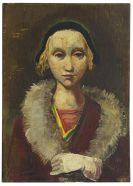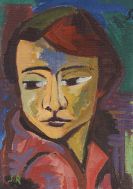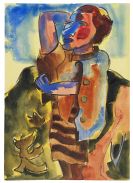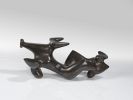
Werner Gilles
Rheydt/Rheinland
1894 -
Essen
1961
After World War I Gilles became a student of Walther Klemm's at the "Weimarer Akademie", but in 1919 he transfered to the newly founded "Bauhaus", where he attended Lyonel Feininger's class. Until 1923 the artist remained registered at this art and design school. During this time Werner Gilles was friends with Gerhard Marcks and Oskar Schlemmer. In 1921-22 Gilles decided to travel to Italy for the first time. Werner Gilles post-graduate life was marked by continuous moves: Between 1925 and 1930, after a further trip to Italy, he stayed in Düsseldorf, Paris and Berlin.
During his first trip to the Italian island of Ischia in 1932 Gilles discovered the things that inspired his imagination for painting: the unification of antique Paganism and western Christianity of past and present.
Werner Gilles discovered the central subject of his pictures. In his oil paintings and his watercolors Gilles depicts the buoyant and the threatening sides of this primordial landscape and captures its basic nature in ever new variations, which are created outside in the open countryside. Gilles' favourite themes came to fruition in two Orpheus Cycles in 1947-49 and in the watercolors illustrating the "Tibetan Book of the Dead" painted in 1950.
His late works combined various stylistic impluses. Werner Gilles early southern landscapes of the 1920s were based on the painting techniques of the "Murnauer Schule" and the "Blauer Reiter". Towards the end of the 1930s a classical formal language can be observed in his drawings and paintings. During and after the war his works were determined by simplifying stylisations of objects and figures and an increasing planeness of composition. From 1951 Gilles spent his winters in Munich and his summers on the Italian Island of Ischia.
Werner Gilles died on June 23, 1961 in Essen, Germany.
Would you like to sell a work by Werner Gilles?
Infos for seller









